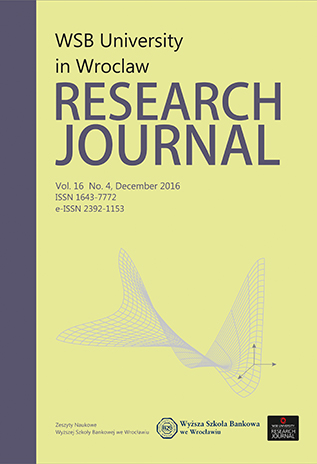A fragility approach to campus sustainability – methodological explorations
DOI:
https://doi.org/10.29015/cerem.376Słowa kluczowe:
Q01, B40, I23Abstrakt
Aim: Often, the approach towards entering a path of sustainable development is that intervention needs to take place. This may lead to unwanted side effects. This paper presents the basis for explorative research on campus sustainability. The aim is to create a basis for developing a methodology for identifying fragilities, threats to organizational viability and sustainable development of the external environment.
Design / Research methods: The ideas presented in this paper were developed through literature study and discussed during three explorative research workshops organized in May and June 2016 at the WSB University in Wrocław (Poland), the University of Sonora (Hermosillo, Mexico) and Siauliai University (Lithuania). The ideas developed are the basis for future research on the issue.
Conclusions / findings: Although more elements are included in the survey, representing elements of organizational viability and mental models directing the path of change. The survey presented and discussed in reflection papers in this volume will be the base for further research on how to improve campus sustainability by eliminating unsustainabilities.
Originality / value of the article: While the traditional approach towards campus sustainability is what action should be undertaken in order to support this aim, in this paper focus is on what not to do. It can be expected that this approach leads to less undesired side-effects than an interventionist approach.
Bibliografia
Alvesson M., Spicer A. 2012, A stupidity-based theory of organizations, “Journal of Management Studies”, vol. 49, no. 7, pp. 1186-1220.
Gates B. 2014, Bill Gates: People don't realize how many jobs will soon be replaced by software bots, “Business Insider”, no. 13 March 2014, http://www.businessinsider.com/bill-gates-bots-are-taking-away-jobs-2014-3 [12.09.2016].
Harford T. 2011, Adapt – why success always starts with failure, Little, Brown, London.
Kahneman D. 2011, Thinking, fast and slow, Penguin Books, London.
Meadows D. 1998, Indicators and information systems for sustainable development, The Sustainability Institute, Hartland.
Perrow, C. 1999, Normal Accidents, Princeton University Press, Princeton .
Platje J. 2008, ““Institutional Capital” as a Factor of Sustainable development – the importance of an institutional equilibrium”, “Baltic Journal on Sustainability”, Vol. 14, No. 2, pp. 144-150.
Platje J. (2011), Institutional Capital - creating capacity and capabilities for sustainable development, Wydawnictwo Universytetu Opolskiego, Opole.
Platje J. 2015, Beyond resilience – new institutional economics, fragilities and indicators of unsustainability, “Central and Eastern European Journal of Management and Economics”, vol. 3, no. 4, pp. 295-315.
Platje J. 2015a, Sustainability and antifragility, “Economic and Environmental Studies”, vol.15, no. 4, pp. 469-177.
Taleb N.M. 2007, The Black Swan - the impact of the highly improbable, Penguin Books, London.
Taleb N.M. 2012, Antifragile - things that gain from disorder, Penguin Books, London.
Thomas I. Depasquale J. 2016, Connecting curriculum, capabilities and careers, “International Journal of Sustainability in Higher Education”, vol. 17, no. 6, pp. 738 – 755.
Sintov N., Dux E., Tran A. , Orosz M. 2016, What goes on behind closed doors?: How college dormitory residents change to save energy during a competition-based energy reduction intervention, “International Journal of Sustainability in Higher Education”, vol. 17, no. 4, pp. 451 – 470.
Sterman J.D. 2000, Business dynamics: system thinking and modelling for a complex world, Irwin / McGraw Hill, Boston.
Pobrania
Opublikowane
Numer
Dział
Licencja
Autor przenosi nieodpłatnie na Wyższą Szkołę Bankową we Wrocławiu , bez ograniczeń terytorialnych, majątkowe prawa autorskie do tego utworu w rozumieniu ustawy z dnia 4 lutego 1994 roku o prawie autorskim i prawach pokrewnych ( Dz.U. 1994, Nr 24, poz. 83 ze zm. )na zasadzie wyłączności, tj. prawo do:
a) wyłącznego używania i wykorzystania utworu w dowolnej działalności przez Wyższą Szkołę Bankową we Wrocławiu, w szczególności w działalność Biblioteki Cyfrowej uruchomionej przez Wyższą Szkołę Bankową we Wrocławiu
b) wytwarzania, utrwalania i zwielokrotniania egzemplarzy utworów wszelkimi technikami, w tym techniką drukarską, reprograficzną, zapisu magnetycznego oraz techniką cyfrową, w szczególności ich zwielokrotniania poprzez dokonywanie zapisów na płytach typu CD,
c) zamieszczenia wybranych fragmentów utworu w celach promocyjnych w publikacjach, materiałach promocyjnych, w sieci Internet oraz sieciach wewnętrznych typu Intranet Wyższej Szkoły Bankowej we Wrocławiu,
d) wprowadzania utworu do pamięci komputera Wyższej Szkoły Bankowej we Wrocławiu,
e) kopiowania i powielania utworu w technologiach fotomechanicznych lub innych znanych w dniu zawarcia umowy (fotokopie, kserokopie itp.),
f) przetworzenia dzieła na formę elektroniczną i nieograniczonego rozpowszechniania w sieci Internet.


